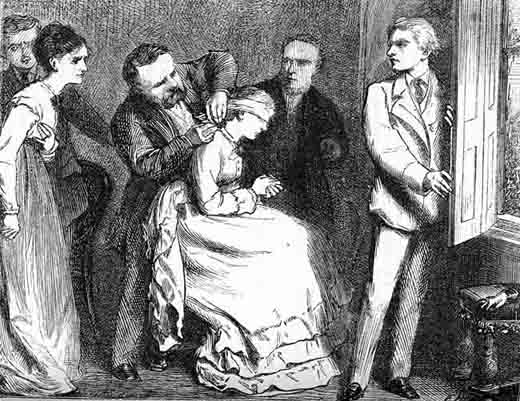Dear Serial Readers,
After reading Plotaholic's Complaint, I had to laugh when I began this installment of "Amos Barton." At the start of the fifth chapter, the narrator launches into a long defense of this "unmistakably commonplace" story about a man of "insignificant stamp." It's almost as if Eliot is daring readers to fling aside her experiment in realism, which is more "Scenes" than story: "As it is, you can, if you please, decline to pursue my story farther; and you will easily find reading more to your taste, since I learn from the newspapers that many remarkable novels, full of striking situations, thrilling incidents, and eloquent writing, have appeared only within the last season." Go ahead, toss this aside, the narrator challenges: realism (at least Eliot's version here) *is* boring!
Besides thinking of Charlotte Bronte's opening of SHIRLEY where she tells her readers that if they are hoping for "passion, and stimulus, and melodrama" to "calm your expectations; reduce them to a lowly standard," I also thought of a novel written nearly forty years after this one--George Gissing's NEW GRUB STREET. At one point a character plans to write a novel that as "honest reporting" would be "unutterably tedious." Is this the experiment in realism Eliot initially attempts in her first published fiction here? What are the limits of the commonplace and tedious?
While I wouldn't call this a memorable story at all (and perhaps Eliot learned that she needed a larger space for a fuller development of narrative since the next two stories are progressively longer still), there were at least two memorable scenes for me: Nanny giving the pampered Countess a piece of her mind which results in the Countess's overdue departure from the Barton home AND Milly Barton's death and its effects on her children of different ages and on Amos.
As I said last time, I am surprised at how sustained and frequent are the interruptions by the narrator who addresses "dear reader." Maybe Eliot is trying to figure out the balance of story and narration, of the commonplace and enough narrative interest. At least these addresses to "you" do attempt to pull the reader into the story. We'll see whether she advances from "Scenes" to something more like plot as we head into the second story, "Mr. Gilfil's Love-Story." But I admit that these "Scenes" with her fabulous word-work do appeal to me.
For next time: chapters 1-2 "Mr. Gilfil's Love-Story."
Serially in scenes,
Susan

3 comments:
So far "Scenes" has held my attention with Eliot's strong voice, her sharp eyeing of everything, not least the human heart: "... and he could never show her his love any more, never make up for omissions in the past by filling future days with tenderness. ..., and he felt as if his very love needed a pardon for its poverty and selfishness." We'll see how "Gilfil" goes.
I agree that Mrs Barton's death scene, particularly how her children reacted was one of the most affecting of the book. I did find the character of Amos Barton not fleshed out enough. We are often told by the author that he is an awkward personality, but not shown him in action very much. Ironic, since he is the "hero" of the story.
I was struck by Mr. Cleves, the one positive portrait of a clergyman, who "knows how to disencumber ideas of their wordy frippery," which I still maintain the narrator does not. I loved that phrase! I think one scene that could be memorable, but I try to forget, was the workhouse scene.
But this is more a portrait of a moment and a place than a narrative.
I also laughed a bit at the opening, also wondering if it replied to readers' comments in the interim.
Post a Comment